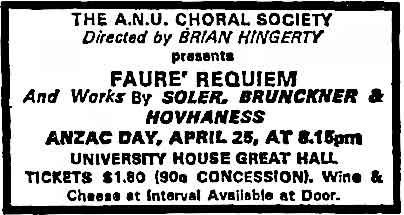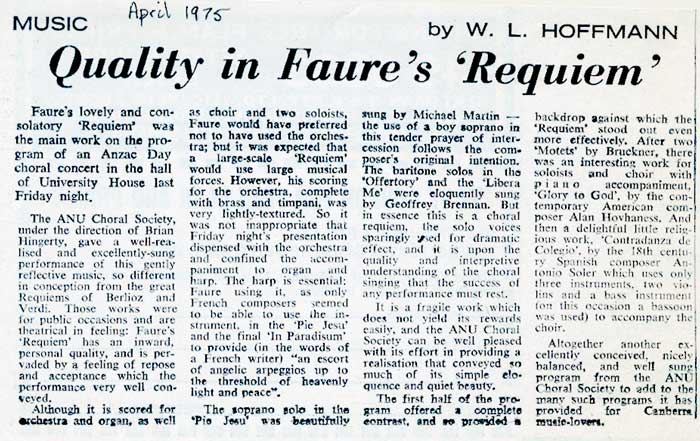

SCUNA history » Concerts » 1975 - 1 » Review
On this page: Advertisement | Review

THE A.N.U. CHORAL SOCIETY
Directed by BRIAN HINGERTY
presents
FAURE' REQUIEM
And Works By SOLER, BRUNCKNER & HOVHANESS
ANZAC DAY, APRIL 25, AT 8.15pm
UNIVERSITY HOUSE GREAT HALL
TICKETS $1.80 (90c CONCESSION). Wine & Cheese at Interval Available at Door.
Source: Advertising. (1975, April 19). The Canberra Times (ACT : 1926 - 1995), p. 13. Retrieved June 27, 2013, from Trove: http://nla.gov.au/nla.news-article116343335

[Handwritten: April 1975]
Faure's lovely and consolatory Requiem was the main work on the program of an Anzac Day choral concert in the hall of University House last Friday night.
The ANU Choral Society, under the direction of Brian Hingerty, gave a well-realised and excellently-sung performance of this gently reflective music, so different in conception from the great Requiems of Berlioz and Verdi. Those works were for public occasions and are theatrical in feeling: Faure's Requiem has an inward, personal quality, and is pervaded by a feeling of repose and acceptance which the performance very well conveyed.
Although it is scored for orchestra and organ, as well as choir and two soloists, Faure would have preferred not to have used the orchestra; but it was expected that a large-scale Requiem would use large musical forces. However, his scoring for the orchestra, complete with brass and timpani, was very lightly-textured. So it was not inappropriate that Friday night's presentation dispensed with the orchestra and confined the accompaniment to organ and harp. The harp is essential: Faure using it, as only French composers seemed to be able to use the instrument, in the Pie Jesu and the final In Paradisum to provide (in the words of a French writer) "an escort of angelic arpeggios up to the treshold of heavenly light and peace".
The soprano solo in the Pie Jesu was beautifully sung by Michael Martin - the use of a boy soprano in this tender prayer of intercession follows the composer's original intention. The baritone solos in the Offertory and the Libera Me were eloquently sung by Geoffrey Brennan. But in essence this is a choral requiem, the solo voices sparingly used for dramatic effect, and it is upon the quality and interpretive understanding of the choral singing that the success of any performance must rest.
It is a fragile work which does not yield its rewards easily, and the ANU Choral Society can be well pleased with its effort in providing a realisation that conveyed so much of its simple eloquence and quiet beauty.
The first half of the program offered a complete contrast, and so provided a backdrop against which the Requiem stood out even more effectively. After two Motets by Bruckner, there was an interesting work for soloists and choir with piano accompaniment, Glory to God, by the contemporary American composer Alan Hovhaness. And then a delightful little religious work, Contradanza de Colegia, by the 18th century composer Antonio Soler which uses only three instruments, two violins and a bass instrument (on this occasion a bassoon was used) to accompany the choir.
Altogether another excellently conceived, nicely balanced, and well sung program from the ANU Choral Society to add to the many such programs it has provided for Canberra music-lovers.
- The Canberra Times, 28 April 1975